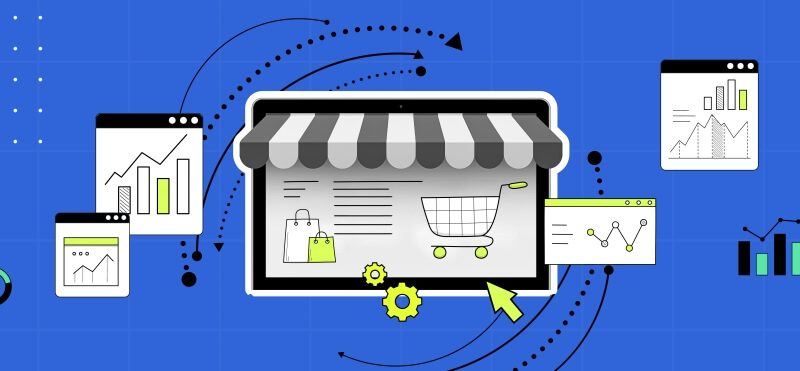As online marketplaces continue to revolutionize the way we buy and sell, reselling on Amazon has emerged as a lucrative business model. Amazon, a company that started as a humble online bookstore, has now become a behemoth in the e-commerce industry. The platform offers infinite opportunities to resellers, enabling them to reach a global customer base and reap substantial profits.
In this article, we will review how to resell products on Amazon, what are the best reselling strategies and also what the future might hold for technological advancements in e-commerce.
Basics of reselling on Amazon
Reselling, in simple terms, involves purchasing products at a lower cost and selling them at a higher price, often through a different sales channel. Amazon has become a preferred platform for resellers due to its vast customer base, streamlined selling process, and advanced fulfillment options.
Definition and explanation of reselling
Reselling, also known as retail arbitrage, is a business model that involves buying products at a low price and then selling them at a higher price. This can be done either by purchasing products wholesale or by finding discounted items from various sources and selling them for a profit. The central idea behind reselling is to capitalize on price discrepancies in different markets or platforms.
Importance of reselling on Amazon and its benefits
Reselling on Amazon is a popular choice for many entrepreneurs due to the platform’s extensive customer reach and advanced selling tools. Here are a few key benefits:
- Access to a global market: Amazon operates in multiple countries and regions worldwide, providing resellers with a vast, diverse customer base.
- Ease of operations: With services like Fulfillment by Amazon (FBA), resellers can store their products in Amazon’s fulfillment centers. Amazon takes care of storage, packaging, and shipping, as well as customer service and returns.
- Trust and credibility: Amazon is a well-established and trusted brand. By selling on Amazon, resellers can leverage this trust to attract customers.
- Scalability: Amazon’s infrastructure allows resellers to start small and scale their business as demand increases.
Find out what are the best products to sell on Amazon FBA in our comprehensive guide on top-selling items.
Understanding Amazon’s policy on reselling
While reselling is allowed on Amazon, it’s essential to understand and abide by their policies to maintain a successful seller account. Here are some key points:
- Product authenticity: All products sold on Amazon must be authentic. Selling counterfeit or pirated goods is strictly prohibited and can result in account suspension.
- Documentation: Resellers might be asked to provide invoices or other documentation to prove the authenticity of their products.
- Restricted products: Certain categories of products require approval from Amazon before listing. Also, some products are completely restricted from sale.
- Product condition: All new products must be brand new and unused. If you’re selling used items, they must be listed as used and accurately described.
Understanding and adhering to these policies is crucial to ensure a smooth reselling experience on Amazon.
How to become a successful seller on Amazon
Becoming a successful seller on Amazon starts with registering as a seller and creating a compelling seller profile. The next step is to choose the right product to resell. This requires thorough research and understanding of customer needs, market trends, and product profitability. Let’s look at how this process works.
Registration process to become a seller on Amazon
Your reselling journey begins on Amazon’s Seller Central page where you click the “Register now” button. You’ll then choose the type of seller account that aligns with your goals. An ‘Individual’ account is perfect for those planning to sell a few items only, while a ‘Professional’ account is tailored for regular business sales.
During registration, you’ll need to provide pertinent details such as your business name, legal name, and contact information. After setting up your billing method and agreeing to Amazon’s Seller Agreement, your account is ready to go. You can then start listing the products you want to sell.

Choosing the right product to resell on Amazon
The process involves multiple steps, each requiring detailed research and analysis. Here’s a more in-depth look at how to make the right product selection.
Market research
The first step in choosing the right product for reselling on Amazon is conducting comprehensive market research. This involves identifying current trends, understanding what customers are buying, and what potential profit margins you can expect.
- Amazon’s Best Sellers list: This list provides an overview of the most popular items on Amazon within various categories. It’s a great starting point to see what’s trending and what products are selling best.
- Google Trends: It’s another excellent tool for product research. Google Trends show you how a particular product’s popularity has changed over time, allowing you to identify items on the rise or consistent top performers.
- Keyword research tools: Keyword research tools, like Helium 10 or Jungle Scout, can provide insights into the demand for a product based on search volumes. They can also offer competitive data, helping you assess the level of competition for different product niches.
Find out how to sell books on Amazon with our seller’s guide.
Competitor analysis
Another crucial aspect of product selection is understanding what your competitors are selling. Analyzing their product offerings, pricing strategies, customer reviews, and overall performance can help identify gaps in the market that you can use to your advantage. For instance, if you find a product with high demand but poor reviews, you might be able to offer a higher-quality alternative.
Understanding customer needs
Understanding customer needs is vital when choosing a product to resell on Amazon. You want to find products that solve problems or fulfill specific needs for customers. Look at customer reviews and feedback on similar products to identify common complaints or wishes. For example, if customers are consistently complaining about a lack of durable phone cases in a certain style, that could be a potential product opportunity for you.
Profitability analysis
Finally, while a product might be popular and in-demand, it’s crucial to assess its profitability. Consider factors like the cost of goods sold, Amazon fees, shipping and handling costs, and your desired profit margin. Tools like the Amazon FBA Calculator can help you estimate potential profits before you decide to list a product.
Bottom line
Choosing the right product to resell on Amazon involves thorough research, analysis, and an understanding of customer needs. By taking the time to go through this process, you can increase your chances of finding a profitable product that will contribute to your success as an Amazon reseller.
Learn how to sell on Amazon without an inventory.
Pricing strategies for reselling products on Amazon
Setting the right price for your products is a key determinant of success when reselling on Amazon. A well-thought-out pricing strategy can significantly impact your sales, profitability, and competitiveness. Here’s a more detailed look at some pricing strategies you can employ.
Competitive pricing
This technique involves setting the price of your products based on what your competitors are charging. It’s a strategy that requires constant monitoring and adjustment as competitors change their prices. Tools like Keepa or Camelcamelcamel can help you track price changes on Amazon and stay competitive. However, while setting competitive prices, remember to factor in your costs to ensure you maintain a healthy profit margin.
Dynamic pricing
When using dynamic pricing, you adjust prices based on market conditions, including demand, time, and inventory levels. For instance, if a product’s demand increases during a particular season, you can raise the price to maximize profits. Conversely, if you have excess inventory that you need to move, you might lower the price to encourage sales. Several software solutions can automate dynamic pricing for you, adjusting your prices based on rules you set and current market conditions.
Value-based pricing
This method involves setting prices based on the perceived value of your product to the customer. If your product offers unique features, high quality, or other advantages that make it stand out from the competition, customers may be willing to pay a premium for it. This strategy requires a deep understanding of your target customers and what they value in a product.
Cost-plus pricing
Cost-plus pricing is a straightforward strategy where you add a fixed percentage markup to your costs to determine the price. This ensures you cover all your costs and make a profit on each sale. However, this strategy doesn’t take into account customer demand or competitor pricing, so it’s best used as a starting point before considering other strategies.
Bottom line
Pricing is a complex but crucial aspect of reselling products on Amazon. It requires careful consideration of various factors, including costs, competition, customer perception, and market conditions. By employing a well-thought-out pricing strategy, you can drive sales, maximize profits, and enhance your competitiveness in the marketplace.
Marketing strategies for reselling on Amazon
Marketing your products effectively is vital to stand out in the crowded Amazon marketplace. So let’s review some marketing strategies that have the potential to drive sales and profitability.
Leveraging Amazon’s marketing tools for reselling success
Amazon provides a wealth of marketing tools designed to help sellers achieve reselling success. Services like Sponsored Products and Amazon Advertising can help you reach a wider audience and increase your product visibility. Amazon Brand Registry, for sellers with registered brands, offers additional tools to enhance your brand presence and protect your intellectual property.
Enhancing product visibility through Amazon’s search engine optimization (SEO)
Amazon’s Search Engine Optimization (SEO) is another crucial marketing strategy for reselling success. SEO involves optimizing your product listings with relevant keywords to improve their visibility in Amazon’s search results. This involves the strategic use of keywords in your product title, description, and backend keywords. Providing detailed and accurate product information helps improve your product’s relevance to customer searches.
Utilizing influencer marketing to boost product sales on Amazon
Influencer marketing can significantly boost your reselling business on Amazon. Influencers, especially those with a large follower base, can expose your products to a wider audience, increasing their exposure.
Recommendations from influencers can boost your product’s credibility and trustworthiness, helping you win over potential customers. Influencers can also create engaging content around your product, driving traffic to your Amazon listing, and, as a result, increasing sales.
Tips and tricks for reselling products on Amazon
Succeeding as a reseller on Amazon involves more than just listing products for sale. It requires strategic planning, ongoing optimization, and a relentless focus on customer satisfaction. Here’s a deeper dive into some best practices for reselling on Amazon.
Conducting thorough market research
Understanding your market is crucial to your success on Amazon. This involves identifying the most popular products, current market trends, and understanding what your competitors are doing. Use tools like Amazon’s Best Sellers list, Google Trends, and various keyword research tools to identify profitable product opportunities. Regularly reassess your market to keep up with changes and stay ahead of the competition.
Pricing products competitively
Your pricing strategy can significantly impact your sales and profits. Monitor your competitors’ prices and consider employing strategies like psychological pricing or dynamic pricing. Remember, however, to always factor in your costs to ensure each sale is profitable.
Providing excellent customer service
Customer service is a key differentiator for Amazon sellers. Respond promptly to customer inquiries and resolve issues in a professional and courteous manner. High-quality customer service can help you build a positive seller reputation, earn repeat business, and encourage positive reviews.
Maintaining high product quality
Customers expect high-quality products when shopping on Amazon. Regularly inspect your inventory to ensure it meets these expectations, and work closely with your suppliers to address any quality issues. Offering high-quality products can lead to positive reviews and fewer returns, boosting your seller reputation.
Optimizing product listings
Your product listings are your primary means of attracting customers on Amazon. Use high-quality photos, write compelling and accurate product descriptions, and use relevant keywords to improve your listings’ visibility in search results. Regularly review and update your listings to ensure they remain optimized and competitive.
Handling customer reviews and feedback on Amazon
Customer reviews and feedback significantly influence buyers’ purchase decisions. Aim to respond promptly and professionally to all feedback, demonstrating your commitment to customer satisfaction. Positive reviews can boost your sales, while negative reviews can provide valuable insights into how you can improve your products or service.
Managing shipping and returns for products resold on Amazon
Efficiently managing shipping and returns is crucial for maintaining customer satisfaction and trust. Use reliable shipping services to ensure your products reach customers quickly and in good condition. Also, clearly communicate your return policy to customers. A fair and straightforward return policy can help manage customer expectations, reduce potential disputes, and build trust.
The future of reselling on Amazon
As the world’s largest e-commerce platform, Amazon is continually evolving, driven by changes in consumer behavior, technology, and the broader e-commerce landscape. Successful Amazon resellers are those who can anticipate and adapt to these changes. Here’s a closer look at how to predict trends in Amazon reselling.
Keeping up with technological advancements
Technology is another crucial factor influencing the future of Amazon reselling. For example, artificial intelligence (AI) is increasingly being used in e-commerce for personalized product recommendations, customer service, and pricing strategies.
Additionally, advancements in logistics technology could impact shipping times, a significant factor in customer satisfaction and repeat business. Similarly, developments in data analytics can provide sellers with more profound insights into their performance, customer behavior, and market trends.
Therefore, it’s crucial to stay updated with the latest technological advancements and consider how they could be applied to your Amazon reselling business.
Monitoring changes in the e-commerce landscape
The broader e-commerce landscape can also impact trends in Amazon reselling. For example, changes in e-commerce regulations, increased competition from other online marketplaces, or shifts in global trade could all influence how you do business on Amazon.
Keep an eye on industry news, join e-commerce forums and networks, and consider seeking advice from e-commerce consultants to stay informed about changes in the landscape.
Reselling on Amazon: Closing thoughts
Reselling on Amazon presents a wealth of opportunities for entrepreneurs to carve out profitable niches within the vast and ever-evolving e-commerce landscape. With millions of customers worldwide, Amazon offers a platform where innovative ideas can transform into thriving businesses.
Choosing the right product is often the starting point of a successful Amazon venture. However, the secret to enduring success on Amazon is a customer-centric approach. Today’s customers expect more than just high-quality products; they seek exceptional customer service, fast and reliable shipping, and a seamless shopping experience. By placing customers at the center of your business, you can build a positive brand reputation, foster customer loyalty, and encourage positive reviews – all of which can drive repeat business and attract new customers.
Venturing into the world of Amazon reselling is a journey that requires patience and persistence. Success seldom comes overnight; it’s the result of consistent efforts, trial and error, and a willingness to adapt to changing market dynamics. Furthermore, continuous learning is essential. Whether it’s staying updated with Amazon’s policies, exploring new marketing techniques, or understanding emerging e-commerce trends, a commitment to learning can equip you with the knowledge and skills to navigate the challenges of Amazon reselling.
So while the journey of Amazon reselling is filled with challenges and competition, it’s also an exciting venture that can lead to substantial rewards. With the right approach and mindset, you can seize the opportunities presented by Amazon’s platform and build a successful reselling business.







.png)
